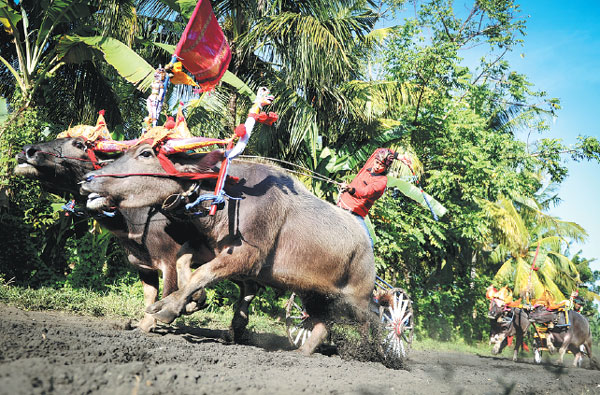Buffalo racers sustain tradition
What started off as a bit of fun evolved into a competition for locals each year
Wearing crowns and colorful horn coverings, the buffaloes haul wooden carts at high speed past paddy fields on Bali, with the racers aboard cracking whips in a bid to push their beasts on to victory.
Hundreds of spectators cheer from the sidelines, hoping their team will come out on top in the annual festival on the Indonesian island reminiscent of chariot racing.
|
Participants compete in a Makepung or bull race with domestic water buffaloes in the Jembrana district on Bali island, Indonesia, in July. Sonny Tumbelaka / Agence France-Presse |
The buffalo racing, known as Makepung, pits two farming communities against each other in western Jembrana district, in a tradition that marks the rice harvesting season.
A world away from the popular tourist hangouts further south on the island, the races are an awe-inspiring spectacle that see participants stand on speeding carts with flags fluttering from the top, as two buffaloes pull each of the rudimentary vehicles.
But the races, which have been held annually for decades, are falling out of favor - regular competitors are now elderly and few of the younger villagers are keen to take up the sport.
"I am old now, and there is no new generation," said Kadek Nuraga, 51, who has been racing for the West Ijo Gading community for over 35 years.
"Many of the older racers would like to retire, some are already over 60, but they simply don't have much choice. Somebody needs to preserve the tradition."
Nowadays younger people tend to leave Jembrana once they have reached adolescence in search of better education in cities, and community elders complain that those who stay are more interested in playing video games than the high-speed buffalo races.
One of Nuraga's sons, now aged 27, has already left his village, and he is training his neighbor's teenage son at the weekends so he can take up the reins of the sport in the future.
But training a good competitor takes time and the older a competitor gets, the easier it is for him to fall off a speeding cart, said Makepung chief organizer Made Mara. Some veteran racers have even died after tumbling off speeding carts.
There is such a shortfall of people wanting to take part some teams are having to hire racers, said Komang Hendra, Jembrana tourism chief.
But this costs 100,000 rupiah ($7.50) per race, a hefty sum in a country where many earn the equivalent of two to three dollars a day.
Still for many Jembrana residents the investment is worthwhile due to the potential financial gain.
The typical prize money for each session of the Makepung race is 25 million rupiah ($1,900) but that is split among the whole winning team, often involving 200 people.
But the value of a pair of victorious animals tends to soar on the local market and some can reach prices of 175 million rupiah.
The Makepung tradition started in the 1960s when two communities on either side of the Ijo Gading river took a competitive approach to working their fields, with farmers racing each other as they labored.
What started off as a bit of fun evolved into a serious competition and now the communities field teams each year for the racing season.
The season runs from July to November, with races roughly every two weeks, and this year involved about 300 water buffaloes.



















